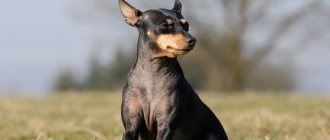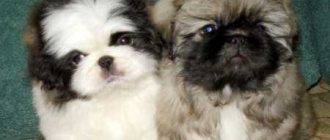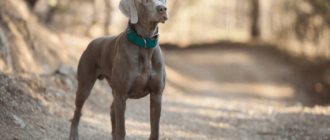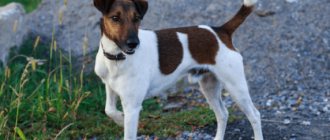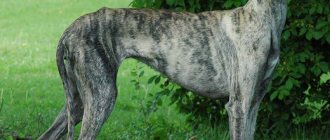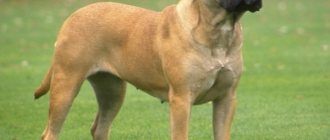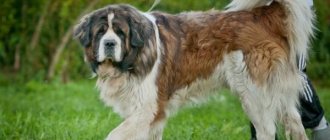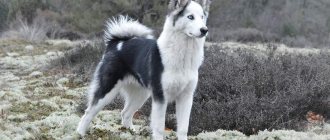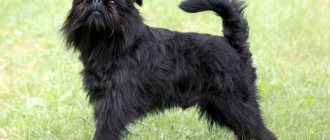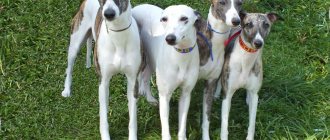Description
A group of wolfhounds is conventionally united by dogs that have the ability to cope with a wild animal. Hunting for strong animals, protection from attack, protection of people and territories can be entrusted to a dog that has certain characteristics and abilities.
- The massiveness of the body, allowing it to overcome the load in the struggle for the protected property of the owner.
- High level of intelligence.
- Reaction speed, lightning speed of attack, helping the dog cope with the instincts of wild animals.
- A special sense of smell for danger, thanks to which the wolfhound senses an approaching enemy.
- Increased level of aggressiveness for defense and attack.
- Fearlessness, courage, the ability to immediately respond to danger, which is specially trained in many. The wolfhound is born with these qualities.
Tall stature, increased body weight, and strong limbs give the wolfhound the ability to run quickly and knock him down.
In all wolfhound dogs, the structure of the skin and coat reliably protects them from wounds and injuries. It helps to survive different weather conditions: heat, strong wind, heavy snowfall or frost. Possessing a powerful grip of their jaws, they strongly squeeze the enemy’s throat, inflicting wounds incompatible with life.
Representatives of wolfhounds are distributed throughout the world. On every continent there are several breeds that are trusted with difficult tasks.
Dogs can independently cope with decisions to attack first without a command, to pursue for a long time, to achieve a goal. Coping with parenting is difficult. It is necessary to achieve impeccable obedience from the dog through numerous training sessions.
The breeds have a highly developed territorial sense. They feel freer in suburban conditions and are not suitable for keeping in small apartments.
Origin story
Most of the breeds from the Wolfhound group have been known for thousands of years and have not undergone any changes. It is believed that selection was made on the basis of performance qualities. It was important not only to correctly use one’s massiveness when attacking an animal, but to have a number of useful properties for humans. The domestication of dogs, which are called “wolfhounds,” began with the selection of more obedient representatives. A person needed an assistant where he could not cope on his own. This led to the following being selected:
- stress-resistant dogs with excellent health;
- hardy hunters pursuing prey;
- fearless fighters for property and territory;
- developed sense of a wild animal, which allows the wolfhound to detect prey.
Not all dog breeds are distinguished by excellent obedience, because... It is prohibited in many countries to select qualities for educational ability. It is believed that this spoils the character and natural instincts of a hunter or guard.
Wolfhound dogs have mastiff-like genes and mastiff-like groups in their blood. The ability to do herding work, understanding human commands, and tracking prey indicate increased stability of the body and high intelligence given at birth.
Coming from the East to Europe, they gradually spread, new breeds appeared, and useful habits were developed. When humanity no longer needed to hunt in large quantities, the qualities of protection from the beast gradually began to appear. Today, many dog breeds are considered companions, serve in law enforcement agencies, are reliable rescuers, and security assistants.
The owner of a wolfhound must always remember that the ancient instincts inherent in genetics can manifest themselves at any dangerous moment. Therefore, you need to carefully monitor your behavior.
Armenian wolfhound
Armenian Wolfhound
This type of dog is also not accepted into the International Association. Therefore, the owner of the dog cannot exhibit it, although the dog can be trained and used in the police and army. She could be a lifesaver.
The dog is strong and has a keen sense of smell; it can easily find victims in the rubble and pull them out.
Interesting: How do dogs see? Do dogs see colors? Description, comparison with a person, photos and videos
The wolfhound from Armenia is an excellent watchdog. Dogs have different colors; there is no established standard yet. Armenian cynologists claim that this breed existed even before our time.
The breed was recognized in Armenia only in 2011. You can buy such a dog only in Armenia. It costs 200-300 $.
Wolfhounds differ in their habits, but they are all very strong, large, and have excellent health. Dogs live for about a decade and a half. The main type of care, in addition to feeding, shelter and training, is vaccination.
Types of wolfhounds
There are more than 20 breeds in the world that are conventionally classified as wolfhounds. All of them are either ancient breeds or selectively bred specifically to solve problems of hunting, guarding, and defense. In countries where there is a danger of a wild animal attacking property, the wolfhound is especially valued and is considered an asset of the state.
Caucasus region, Türkiye
Natural conditions, the prevalence of wild animals, and cattle breeding as a leading agricultural activity made it possible to breed special dogs. They mainly belong to the groups “herding shepherd dogs” and “mastiffs”.
Akbash
The Turkish Wolfhound is an ancient breed that has not undergone selection. Bred in the Middle Ages to protect against attacks, as a companion dog. The height of an adult male is more than 80 cm, and it weighs a little - about 50 kg. Snow-white wool with undercoat makes it easy to get lost in a herd of sheep. When working, the wolfhound herds them into groups, leads them to the pasture, and finds lost cattle. Light weight allows you to cover long distances without effort. The breed is still not recognized internationally. The general appearance resembles a mongrel and to those who are not familiar with the characteristics of the dog, it seems harmless. Not dangerous to humans, but can attack first if there is danger.
Gampr
The dog comes from Armenia. According to historians, the wolfhound was domesticated in the period 1 thousand BC. The breed's task is to accompany nomadic tribes and protect property. It is believed that the dog became the ancestors of the Eastern Shepherds. Externally similar to alabai. The same height, structure and character traits. The exception is lower weight. They need the earliest possible socialization and strict education. In terms of behavior they are considered the most unpredictable.
Gurdbasar
A breed from Azerbaijan, which is intended for herding livestock, accompanying people on hikes, and protecting property. An ideal dog for mountain regions. Due to the dense coat of sandy or red color, the wolfhound does not freeze. Tall, strong limbs help to move quickly and overcome obstacles. A guard wolfhound will never betray its owner. Will notify you of dangers in time by barking and growling. An attentive dog for whom it is important to be close, obey and help.
Kangal
Originally from Turkey. An indigenous breed of wolfhounds, prohibited for breeding in other countries. They belong to the “mastiff” group. Weight reaches 65 kg. with a height of 81 cm. The structure is typical for mastiff-like dogs: a square head with a dark mask, a developed chest and neck, a toned body and massive muscle mass. The psyche is stable. The dog's high level of intelligence allows it to remember the owner's voice, commands, gestures, and things. Whenever an attempt is made to violate “boundaries,” he responds with an increased level of aggressiveness.
Suspicious of strangers, does not tolerate screams or noise. It reacts to a stranger with a warning bark and can quickly attack. For the family, he is a loyal dog, considering everyone as his pack.
Nagazi
A large-sized Georgian wolfhound, not recognized anywhere except in its homeland. Valued for stress resistance and endurance. Experts classify the dog as a mastiff or molosser based on its working qualities. He knows how to lead a flock of sheep and rams to pasture, and then take them back without human intervention. The dog is loved for its flexibility and developed intelligence. Tall growth and thick fur helps him see his surroundings in any weather conditions and remember his location. The endurance of the wolfhound is explained by its specific body structure.
European countries
In Europe, dogs have been known since the times of Ancient Rome and Greece. They were used as fighting dogs, guards, and defenders. They performed rigging work and took part in hunting wild animals.
Irish Wolfhound
The ancestor of the breed is a Celtic dog that accompanied the Vikings. A little later, fearlessness, tracking an animal by blood, and driving qualities were noted. Known since medieval times, when it was necessary to protect the territories of castles, fortresses, and camps. Active use as a wolfhound continued until the 20th century. They never show bitterness and cannot be a reliable defender.
They are related to greyhounds due to their long limbs and the ability to run, catch up, and pursue at lightning speed. As an assistant in the pastures, a companion is what the dog’s natural abilities are intended for.
Commander
Large size Hungarian Cattle Dog. According to the standard, the height of a male is about 70 cm, females are slightly lower. Weight about 50 kg. The massiveness of the overall appearance is given by the specific appearance of the dog, consisting of long hair curled into peculiar dreadlocks. When running, they develop and become like a sailor's mop. This structure provides additional protection from wounds, injuries, and bad weather conditions.
The dog easily gets lost in a herd of sheep, mimics them and reacts quickly when it needs to be protected. Not afraid to attack first, warns the owner of danger. Treats children well, perceives them as his own offspring. Performs the functions of a guard, watchman, companion, wolfhound. Has a developed intellect to understand not only words, but also gestures. Tries not to lose sight of the owner, so the dog is not inclined to go far or run away. A breed for those who lead a very active lifestyle. Does not tolerate boredom or loneliness.
Maremmo-Abruzzese Shepherd Dog
A cattle breed from one Italian region, where it was valued for its highly developed guarding qualities. A real shepherd who can replace a shepherd. The coat is white with long center hairs. The nose, lip rims and eyes are dark. The Wolfhound from Italy is a typical shepherd: smart, understanding, sociable. The main advantage of a dog is its love for humans. A hardy, serious dog, capable of making his own decisions and acting impulsively. The owner will have to work hard to teach basic commands and impeccable obedience.
Pyrenean mountain dog
The snow-white coat makes the breed invisible on snowy slopes. It originated in France, where it is still very popular. The dog is valued for its ability to make long journeys over rough terrain. High limbs and a toned body make the dog agile and active. Weighing 50 kg and taller than 80 cm, she looks elegant. It vaguely resembles a Spitz-shaped Samoyed, similar to a polar bear. The dog is considered to be intellectually developed. A friendly attitude is something that is given from birth. This is exclusively for our own people, the owner. If a puppy or junior shows even the slightest aggression, then this is considered a culling in the litter.
Giant Schnauzer
It is still unknown when the breed appeared. This is approximately the end of the Middle Ages for hunting and guarding, like the wolfhound. For breeding, ordinary dogs were selected from villages to protect pastures. To improve working qualities, the blood of Flemish Shepherds and Great Danes was added. It turned out to be an excellent assistant with the exterior of hunting breeds. Outwardly he resembles a terrier. The muzzle is decorated with a “beard” and eyebrows made of long spinous hair.
To give a neat appearance, the dog must be trimmed. Without this, she looks unkempt and shaggy. Very tall stature, strong limbs and a toned body allow him to jump high and run fast. The character is very calm after growing up. At the age of a puppy, a junior, he is an active, cheerful, cheerful dog. Easily makes friends with other dogs and cats. They do not perceive other pets as prey. They take part in games on the “dog playground” with pleasure. For household members, he acts as a guard and protector.
Russia
In a country where hunting and cattle breeding were considered traditional occupations, many wolfhounds were bred, which are popular all over the world due to their excellent working qualities.
Buryat-Mongolian wolfhound
The breed is similar in appearance to the Bernese Mountain Dog in color and appearance. Black coat with red and white spots with a rich undercoat protects from wind, snow, and water. The wolfhound is predisposed to endure the conditions of the steppe due to the fact that it originated in the vastness of Mongolia and is widespread in the north. Recognized only by the Russian Cynological Federation. According to the standard, the weight exceeds 45 kg, but should not be higher than 70. Height ranges from 65 -75 cm. The formation of breed characteristics and description belongs to enthusiasts from Buryatia. It was considered a sacred dog that lived in Buddhist monasteries. Today he is a security guard, a companion who is used in the search for things, a person due to his high level of stress resistance and flexible nature.
Caucasian Shepherd Dog
A typical representative of “mountain dogs” with thick hair. There is no consensus on the origin of the breed. Some believe that this is the progenitor of the Tibetan mastiff. Others are guided by the opinion that an Armenian woman crossed the Gampr dog with aboriginal dogs. Outwardly, it vaguely resembles a “Tibetan” except for its smaller size and the absence of a “lion’s mane” around the neck. They are considered the best guards in their class.
They were bred for shepherding work and protection from attacks by animals, wolfhounds. An unpretentious dog for household members that reliably guards the territory. She loves children and family, but she will have to show strong-willed qualities to raise a dog “for herself.” They really don't like violence. During the day you can often find a dog sleeping, and at night he begins to show increased activity.
Russian greyhound
One of the most popular breeds in Tsarist Russia for welding work, hunting, chasing animals, and chasing. A graceful dog with excellent exterior characteristics. This made it possible to make the dog part of the cultural heritage, when paintings, figurines, and sculptures depicting a greyhound were popular in the interior. Due to the specific structure of the elongated muzzle and the location of the eye orbits, it closely monitors future prey, quickly rushes in pursuit, catches up and barks.
It was used for hunting both small rodents and animals larger than the dog itself. Considered a wolfhound. Courage, determination, high speed are the distinctive features of the breed. Loyal to other dogs. Listens to the owner, works according to commands. The owner will have to spend a lot of time training, walking, and running. Without loads, they sharply lose their shape and become flabby.
South Russian Shepherd
To protect fine-wool sheep on the territory of Ukraine and Crimea, guards were needed. The ideal choice was a not too large Asturian Shepherd Dog, which served faithfully, but could not cope with the tasks of protection from attacks by wild animals. Therefore, it was decided to infuse the blood of aboriginal dogs - greyhounds, Tatar shepherds. This is how a new breed of wolfhounds appeared, which began to spread throughout the territory of the Crimean highlands and the Krasnodar Territory.
Outwardly it looks like a large beautiful toy with white fur. It is long, has the ability to be hydrophobic, and covers the torso, limbs, and head. The axial hair covers the eyes from the wind, the undercoat protects from bad weather conditions. The dog's height is slightly higher than 60 cm, standard weight is up to 50 kg. The number of wolfhound fans is constantly increasing due to its beautiful appearance, natural embitterment, stubbornness, and disobedience. This is interesting “material” for the canine service. Loves children, despite his disobedience.
East, Central Asia
Traditionally, wolfhounds are native to these areas. Steppe expanses, mountain ranges, cattle breeding are what contributed to the breeding of breeds.
Alabai
The breed has been known for more than 4 thousand years. It is called the “Central Asian Shepherd Dog”. Initially bred for security and herding work. Purebred representatives are the national pride of Turkmenistan and are prohibited from export in order to avoid selection and deterioration of quality. The size of the wolfhound is enormous. They are complemented by a powerful chest, strong jaws, and muscular limbs. The character is harsh and complex. They must be brought up with maximum severity, monitor their psyche, and prevent dominance over humans and other pets.
Basins
Easy-going, independent and angry - these are the definitions you can hear about this Central Asian Shepherd, considered a wolfhound. An ideal breed for pickling work. Descent from the blood of the Persian greyhound, known for its speed and gracefulness. The dog is used to doing without food, because... its purpose is to protect nomadic tribes on long journeys. The welded method is used to hunt animals.
The character is complex, prone to aggression. The body is covered with gray dog hair with a small undercoat that glistens in the sun and prevents it from overheating. The general appearance of a typical tall greyhound. The breed is not recognized by the international community. The weight is light, the height is high, the fur is small, which allows you to quickly maneuver while running, jumping, attacking in a pack, dodging lunges.
Taigan
An unrecognized, endangered breed of wolfhound from Kyrgyzstan. Belongs to the group “Greyhounds” for hunting wolves and other large animals. It was bred to live in mountain conditions. Etching work is what we do best. It can catch up with a mountain goat, easily knock it down and hold it until the hunters arrive.
The general appearance is typical of greyhounds. The coat is dark with white spots. The muzzle is elongated, the eyes are located on the sides, as are the V-shaped ears, hanging almost to the beginning of the neck. A flexible body and toned body make the dog agile, nimble, and grippy. Makes decisions independently of the person. Parenting is not easy. He behaves well in a pack of his own kind, where he learns from experience.
Tobet
The Kazakh wolfhound does not know fear, fatigue, or cowardice. Habitat and service - Far East. Guards and hunts, helps protect. White thick fur is invisible against the background of snow. The large size of the breed is explained by its proximity to mastiff-like dogs. Due to the hair, the specific structure of the body with a wide chest, and physical strength, it can cope with the beast alone.
It is on the verge of extinction due to the emergence of new breeds with similar qualities and a more loyal psyche. With such a wolfhound, it’s not scary to stay in the mountains at night. He is always on guard. The dog, which is not officially recognized anywhere, is considered a good protector and hunter.
What types exist
Species related to wolfhounds are not all recognized by the FCI. Only some of them are deservedly called purebred dogs.
Maremma Abruzzese Sheepdog
Kangal (dog): Turkish wolfhound, comparison with Alabai
A species of wolfhound with great growth: males up to 73 cm with a weight of about 45 kg. Character traits:
- calm;
- equilibrium;
- self-confidence;
- performance;
- responsibility and dedication.
Note! Animals are patient with children, can make their own decisions, and easily read the owner’s emotions.
Maremma Abruzzese Sheepdog
Russian greyhound
Who is this Russian greyhound? A wolfhound with tall stature and low weight - up to 85 cm at the withers and about 47 kg. The dogs have excellent physical characteristics, represented by:
- acute vision;
- subtle sense of smell;
- normal level of aggression towards wild animals.
Russian wolfhounds easily develop great speed. At home, they are calm and friendly.
Caucasian Shepherd Dog
The ancestors of Caucasians are considered to be the Tibetan Great Dane or individuals resulting from the mixing of Gampras and aboriginal dogs. Dogs have long guarded herds and performed guard duty. Rare migration and lack of mixing with other breeds allowed them to remain unchanged in appearance.
In purebred males, height starts from 68 cm, body weight - from 50 kg. Females are traditionally smaller: at the withers from 62 cm, weight from 45 kg.
Buryat-Mongolian wolfhound (hotosho-nokhoi)
The large dog performs guard functions and is distributed in Transbaikalia, Buryatia, Kazakhstan, China, Mongolia and Tibet. The ancient breed was used in pastures, to guard monasteries and private houses, and in hunting wolves. The Buryat-Mongolian wolfhound grows above 70 cm at the withers and has a corresponding weight.
Bankhars, as these wolfhounds are also called, have excellent health, they do not require special care, and easily adapt to an unfamiliar climate. They get along well with children and the elderly.
Buryat-Mongolian wolfhound
Pyrenean mountain dog
These are wolfhounds that appeared on French territory several centuries ago. Representatives are especially popular in Western Europe, the USA and China. Little is known about the breed in Russia. Adult males reach 80 cm in height and weigh no more than 54 kg.
Pets can serve as guards, shepherds and companions. They need long walks with moderate exercise. Dogs are wary of strangers, but never attack first.
For your information! The breed is used in rescue teams, rehabilitation centers, and as guide dogs. She has such unpleasant traits as resentment, especially for undeserved insults.
South Russian Shepherd
Dogs are distinguished by aggressiveness, endurance, and are capable of defense on an intuitive level. Puppies need to be trained from the first days they arrive in the home. The animals are not suitable for people who have not dealt with guard species. Average height is from 60-65 cm, weight - from 35-50 kg.
The Russian-Southern Shepherd will not obey a person with a weak character. Wolfhounds are able to make their own decisions and are loyal only to the unconditional leader.
Alabai (Central Asian Shepherd)
Aboriginal dogs spread to Central Asia more than 4 thousand years ago. For a long time the breed was called the Turkmen Shepherd; it became Central Asian only in the 19th century. The breed spread to Russian territory during the USSR.
Strong and brave pets are suspicious of strangers and are distinguished by their loyalty and reliability. The physical and intellectual development of its representatives ends by the age of 3. Alabais have a long-term reaction to external stimuli; in order to eliminate the problem, you need to get rid of the cause or switch the dog’s attention to a foreign object.
Central asian shepherd dog
Gampr (Armenian wolfhound)
Self-confident and independent dogs with a height of 67-79 cm and a weight of up to 80 kg. High intelligence and attempts at dominance require early socialization and training.
Important! The breed is not recommended for beginners; pets need a person with an unbending will. As a result of constant communication, friendly relations are established between the dog and the owner. The dogs' primary focus is on protecting younger family members and young animals.
Bavarian Wolfhound (Giant Schnauzer)
The animals are intended to help herd livestock. The main characteristics of the breed include:
- calmness, endurance;
- high intelligence, patience;
- ease of training.
Important! German Wolfhounds are not suitable for people who do not want to go on long walks in any weather. The mobility and activity of pets requires outdoor games.
Kyrgyz Greyhound (Taigan)
Belongs to the group of Central Asian greyhounds, can accompany hunters high in the mountains, and is capable of independently pursuing foxes and badgers. The Asian Wolfhound dog is not recognized by cynological associations and is an endangered species. Dogs with well-developed muscles, up to 70 cm in height, with a calm and balanced character.
The Kyrgyz hound is on the verge of extinction
Anatolian Shepherd (Kangal, Karabash)
Purebred Kangals live in Turkey and are recognized only by their canine organization. Puppies are difficult to remove from the country and cannot be bred in other states.
Anatolian Shepherd Wolfhounds are a mixture of Kangal and other herding dogs. Adults grow up to 81 cm and weigh about 65 kg. Animals can live outside year-round, but in severe frosts they will have to be brought indoors.
Note! Dogs have a developed sense of ownership; they will never allow strangers to touch their owner’s property. Dogs are friendly with children and can be used as a nanny.
Irish Wolfhound
The Irish descended from Celtic dogs, designed for baiting animals during the hunt. Mature males grow above 79 cm and weigh more than 54.5 kg. Pets are friendly and get along well with children.
Important! Irish dogs are not suitable for home guarding; they are good-natured towards strangers. They lack aggressiveness.
Kazakh Greyhound (tazy)
The Eastern or Central Asian greyhound is used for hunting and is not included in the FCI lists. Adults grow up to 70 cm and weigh less than 23 kg. The breed is characterized by:
- endurance;
- activity;
- elegance;
- speed of movement.
For your information! Dogs have increased independence and autonomy. Animals are not capable of vigorously expressing their joy.
Kazakh greyhound
Kazakh wolfhound (tobet)
Lives in the Far East, used for guarding and grazing livestock. It is an endangered species and is not recognized by the FCI. Mature individuals weigh up to 65 kg, reaching 60-76 cm at the withers. What a wolfhound looks like: large, hardy pets are not afraid of rain, cold or heat. They are distinguished by devotion, dedication, and lightning-fast reactions. The Kazakh wolfhound has no fear of wolves; the dogs are afraid of absolutely nothing.
Azerbaijani wolfhound (gurdbasar)
The herding dog is common in the mountain and steppe regions of Azerbaijan. A loyal breed that is loyal not only to the owner, but also to other family members. Smart dogs are easy to train and adapt to new living conditions. Can be used for guard and guard duty. The average height of males exceeds 72 cm, weight starts from 55 kg.
Georgian Wolfhound (Naghazi)
Not recognized by any canine society, according to the description it resembles a group of Molossians. The ancient Caucasian breed appeared in the 5th century. BC e. and has remained virtually unchanged since then. Dogs not only successfully protect livestock from predators, but can also serve as a shepherd.
Hardy, strong animals with good physical characteristics. They easily adapt to cold and heat and are unpretentious. The courageous and independent nature of pets helps them create an aura of confidence and calm. A stable and balanced psyche does not allow unnecessary aggression to manifest itself; dogs guard and herd livestock perfectly.
Mature individuals weigh from 52 to 75 kg, average height is from 72 to 77 cm.
A wolfhound dog is a powerful and dangerous weapon in the wrong hands. Without early socialization and proper training, an unlucky beginner may end up with a wayward, aggressive or completely unruly animal. Coping with a pet that weighs the same as its owner is quite difficult. Without an ODC course, an inexperienced owner will not be able to keep an interested dog, and he will quickly run away to get acquainted with local attractions.
Education and training
Most native wolfhounds are very poorly socialized. A naturally high level of aggression forces dog handlers to look for approaches and motivation to become a more obedient dog.
All wolfhounds are capable of making independent decisions. There may be an intention in their thinking to attack without reason. Therefore, you need to monitor your behavior while walking. Stop any unreasonable attack in time, diverting attention.
It’s easier with shepherd-like and herding breeds. Instinctively, a dog is close to a person. She is obedient, intelligent, open. Not all breeds quickly and easily get used to walking with other dogs. They can be frightened by noises, sounds to which any wolfhound from the group of “cattle herders” will definitely react. If you are planning to get a greyhound, experts recommend getting a pair. It is important for them to work in a group. This way the dog feels better and acts more confidently. A mandatory part of the daily routine is a long walk with the opportunity to run a lot.
It is important for the owner to find the optimal balance between reward and punishment. This is difficult to do, but with regular training, specialists achieve excellent results.
It is absolutely forbidden to beat the wolfhound or scare it. You need to understand the dog’s mood and not overload him with “maximum” care. Small training with simple commands begins at 4 months of age and continues throughout the dog’s life. Perseverance, determination, and masculinity will definitely come in handy when raising a wolfhound.
Irish Wolfhound
The Irish Wolfhound is a dog for the soul, created to communicate with the whole family, he will get along great with a small child and will help the old man bring bags of food into the house. They love to play, go for walks and constantly enjoy being around a person. The energy of this animal is enough for all family members. The wolfhound dog breed is ideal for a country house. The larger your property, the more fun and healthy your dog will be. No matter what kind of protector you are looking for, no matter how much you read about what a wolfhound dog looks like, you will not understand all the charm of the breed without meeting it in person.
Care and maintenance
Wolfhounds, except greyhounds, have thick fur. Many people have undercoat and shedding – something that causes a lot of inconvenience to the owner. Traditionally, in females it begins before estrus, during hot weather and before winter. In males only when the seasons change. The undercoat should be combed. Otherwise, the dog looks untidy.
The Giant Schnauzer will have to be taken to a special “trimming” procedure once every 3 months. A dog groomer processes the coat, gives it a beautiful look by pulling the hair, trims the beard, mustache, and eyebrows.
The dog owner should regularly:
- inspect after a walk to prevent the appearance of exo-parasites;
- wipe the dog’s eyes and ears with antibacterial agents, protect the conjunctiva from inflammation;
- wash the wolfhound’s paws after a walk, especially in winter, when “chemicals” are scattered on the city streets to quickly melt the snow.
When accustoming a wolfhound puppy to the house, you need to take care of organizing a place for a bedding. It should be free from drafts - the cause of many diseases. A soft bedding is needed to avoid the appearance of calluses on the elbows.
The wolfhound is a huge dog. Requires maintenance in a spacious apartment, cottage, or country house. If a wolfhound lives on the street, then a cozy booth or enclosure is needed when there are no plans to release it around the territory of residence. Everyone has a developed sense of territory. It will be difficult for a stranger to enter the house. There will be an immediate warning and attacks. Aggression is an innate feeling in many representatives. You need to know and understand this, cultivate relative loyalty, and not encourage the development of anger.
All wolfhounds require increased physical activity. Otherwise, the dog loses its natural instincts, becomes lethargic, disobedient, and apathetic. She quickly gains weight or begins to openly become a hooligan, destroying everything around her. Prolonged loneliness should not be allowed. The dog experiences this very hard and stops trusting the family.
Nutrition
All large breeds require increased protein foods. Vitamins and microelements must be included in the diet. There are several unspoken rules about what to feed your dog. Ideally, and in the absence of allergies, ready-made food is suitable. It is better to choose a “holistic” class for large dogs. You don't have to calculate your diet.
There are owners who prefer “natural” food, then they will have to cook it themselves.
Regardless of the breed, the wolfhound dog’s menu includes the following components:
- fermented milk products, including cottage cheese for intestinal function and the prevention of dysbacteriosis;
- cartilage containing collagen helps make bones stronger;
- raw meat, which is doused with boiling water, which promotes muscle growth;
- by-products (liver, lung, heart, udder, tripe), which are boiled and added to porridges made from rice, buckwheat, egg or pearl barley;
- fresh vegetables as a source of fiber.
For healthy hair, be sure to give raw eggs, which give strength and shine to the hair.
You should absolutely not do the following if you want your dog to live longer:
- baking;
- confectionery;
- potatoes and starchy products;
- tubular bones that negatively affect the gastrointestinal tract;
- sweets.
You cannot accustom him to the table, feed him leftover human food, to which spices, salt, vinegar-based sauces, and tomatoes are added.
The dog must know the feeding schedule and be able to wait for feeding. Large breeds are fed 2 times a day, puppies up to 5. Be sure to keep an eye on the foods that the wolfhound loves most. Focus on desires to please your pet, but don’t get carried away. The dog will quickly learn to manipulate your feelings and will choose only what is tasty. You need to pamper, but not often, a little.
Health and illness, life expectancy
By nature, the wolfhound has excellent immunity. He is not afraid of weather changes, he knows how to resist viral diseases. This is what distinguishes native breeds. It is genetically determined that the wolfhound feels excellent. Otherwise, it would not have survived in nature.
Traditionally, due to the size and build, the dog has a tendency to develop the following problems:
- obesity caused by good appetite, poor nutrition, which leads to diabetes;
- eye diseases (cataracts, conjunctivitis, ectropion);
- volvulus of the stomach, characteristic of large dogs with a developed sternum, when too much food, water, intense exercise leads to volvulus;
- congenital heart failure;
- dysplasia of the elbow, hip, hock joints.
All dogs, including wolfhounds, are susceptible to infectious diseases: distemper, enteritis, piroplasmosis, ringworm. Prevention requires vaccinations that will create immunity and reduce the risk of disease.
It is necessary to carry out deworming and antiparasitic treatment.
Wolfhounds live on average 8-10 years. With good care, long-livers occur. It all depends on the conditions of detention, nutrition and genetic predisposition. The larger the breed, the shorter its lifespan.
Maintenance and care
Even if the dog is free-range, you still need to walk it for 40 minutes twice a day . It is best to walk Irish Wolfhounds on a leash , although they are successful companions, they still have a strong tendency to chase animals on the street.
be brushed weekly , first with a brush and then with a comb. You can wash it when it gets dirty.
If in winter you walk along streets that are sprinkled with reagents or salt, be sure to thoroughly wash your paws . Due to their large size, there is significant pressure on the paw pads, so salt or chemicals are “pressed” into the skin. This leads to pain, inflammation, and wounds.
Irish Wolfhounds have a tendency to produce excess earwax, so regular ear is recommended .
This breed is not prone to overeating , to make sure that the pet is in good shape, just look at it: the waist should be clearly visible. The dog should be fed twice a day and active play should be avoided one hour before feeding and two hours after to avoid bloating.
Mating
The female is ready for pregnancy after 2-3 heats. An earlier date is a big risk; the body is not yet ready for the birth of offspring. You should choose partners based on the following criteria:
- pedigree line;
- health status;
- presence of experience.
In some cases, you will have to seek the help of a dog breeding specialist.
Before planning a pregnancy, a female wolfhound must undergo anthelmintic therapy and receive all vaccinations as scheduled. To avoid the development of urogenital infections, special medications are prescribed for prophylaxis.
How to choose a puppy, its cost
Wolfhounds are serious dogs for whom it is important to be courageous, courageous, and mentally balanced.
Therefore, you need to be very careful when choosing a puppy.
- Decide on a nursery or breeder of the breed.
- Make sure that the parents have all the documents.
- Ask to see pedigrees and any awards for achievements in the breed if they have taken part in exhibitions.
The puppy must have a veterinary passport and a puppy card. It is worth considering if the breeder is a reseller. An honest owner has nothing to hide. You need to look at the puppy’s mother, ask about the characteristics of the breed and feeding. If you evade questions in any way, you must refuse and look for other options.
Among the wolfhounds there are very cute puppies. You can’t take it just because you liked it from the photo. The choice should take into account the breed inclinations and lifestyle of the future owner.
A healthy puppy stands firmly on its limbs, does not fall over or stagger. He is keenly interested in what is happening around him and does not react to loud sounds with stressful behavior (running away, getting angry, whining). There is no discharge from the natural openings, which is a sign of health.
The price of a wolfhound depends on the rarity of the breed, the number of competitors at exhibitions, and breeding planning. It starts from 200 USD. and ends with more than 2.5 USD. On average, a popular dog breed can be purchased for $500.
Reviews
Angela, 32 years old, I accidentally saw a huge dog with a funny face and hair sticking out in all directions on a trip abroad. I immediately fell in love and decided that if I ever had a dog, it would be like this. My Irish Wolfhound cost a very obscene amount of money. This is our family pride. Arthur is truly handsome. Yes, he was a little rowdy at first, rushing and barking at everyone. Gradually I got used to it. But he and I are definitely not bored. Now he is 3 years old and I am very pleased with the choice.
Valentin Ivanovich, 58 years old I have had Alabai for 5 years. He started it specifically for security purposes. I liked the look, large size, strong paws. Just what you need for an attack. I’ll say right away that it’s difficult to change a dog’s character. Alonso is a serious dog who, if he sees a weakness, immediately shows himself. Calmly stands on his hind legs and pushes. It's good that I have experience. You have to go for a walk with him in a “strict way”, otherwise he will rush to run and that’s it. Consider that you are on the ground, and the dog is dragging. He understands only a serious voice, sternness. But he loves all my friends madly. He hates strangers, sometimes it seems that he is ready to tear him to shreds. I'm definitely calm about the house. A good wolfhound. Simply great. Just what I needed.
Advantages and disadvantages
The positive aspects are considered to be that the wolfhound dog has:
- developed intelligence;
- courage, determination;
- knows how to take responsibility for security.
All breeds tolerate bad weather conditions well. No ongoing specialized care is required.
You should not adopt a wolfhound in the following cases:
- if there is no canine experience and this is the first dog in the family;
- you cannot show decisiveness, boldly, when the wolfhound rushes into a fight;
- lead a quiet lifestyle.
It is better to conduct a general dog training course together with an instructor. You should not specifically teach aggressive commands to kill if you do not plan to use it as a serious guard.
Irish character
The largest wolfhounds in the world also happen to be some of the smartest dogs. The owners confirm that the main character traits of such a dog are restraint, tolerance, generosity, and kindness. The most interesting thing is that a wolfhound dog with its parameters can scare even an adult. But in fact, as dog owners say, they always bond with children, treat them with kindness and care, and become their families' best friends. When meeting smaller dogs that show an aggressive reaction, the Irish simply walk away without getting into a fight. If the enemy is large and strong, then they take a warlike pose, but do not be the first to get into a fight.
Similar breeds
Aboriginal breeds are material for breeding new dogs with more improved characteristics. Therefore, the traits of wolfhounds are found in groups:
- mastiffs due to their fur and suspicious attitude towards others, strangers;
- shepherd dogs because of their devoted attitude towards people, high intellectual level, and well-bred obedience;
- Swiss mountain and cattle dogs, which are independently capable of performing the roles of a shepherd and a guard.
Greyhounds, which are classified as wolfhounds, are united by developed hunting instincts, the ability to work in a pack, drive prey, and pursue for a long time.
When choosing a wolfhound for yourself, you must remember that many breeds naturally have a high level of aggression. At the same time, they can be very calm at home, like all mastiffs.
What dogs are called Wolfhounds?
Contrary to popular belief, the wolfhound dog breed does not exist as such. Wolfhounds are pets that naturally have great strength and power compared to other animals. Such dogs, as practice shows, are very hardy, fearless and characterized by devotion to people despite their independence.
Of course, these basic qualities set them apart from other, smaller relatives. In fact, wolfhound is a collective concept that applies to many large animals. And each of them has unique character traits, appearance and temperament. It is impossible to say specifically what behavior is typical for domestic dogs, since each individual behaves differently (video author - Robo Top).
Initially, wolfhounds were bred for the purpose of hunting wolves, which they did in ancient times. The selection took place differently for everyone, but the goal was the same. Also, dogs that fall into this category have been used for a long time and successfully to protect cattle from predators. Today, these individuals are in most cases used as companions, hunters or guards.
Briefly about the main thing
- Wolfhounds are the oldest breeds that have undergone more than 4 thousand years of domestication by humans.
- They have fearlessness and courage. They boldly go after a wild beast, without fear of being wounded.
- Dogs cannot tolerate strangers, but they treat their household members well, love and value them.
- Wolfhounds require early socialization to avoid the development of ancient instincts of aggression and attack.
- You should only purchase a wolfhound puppy from breeders of the breed with many years of experience who know all the nuances of keeping it.
- Ideal, comfortable conditions for the development of a breed from the Wolfhound group are considered to be a large apartment or a private country house with a fenced area.
- All breeds are distinguished by good health and harsh character.
- The dog must be raised by an owner with canine experience working with large breeds.
Caucasian wolfhound
Caucasian Wolfhound
You can't play with this dog, it's smart and angry. It is used for protection and guard duty. The dog is large, it is not recommended to keep it in an apartment. The animal will not be comfortable in the apartment. It needs coolness, not room temperature. In a private house or in the yard, such a dog will be quite comfortable.
This type of wolfhound does not get along well with the cat tribe. This must be taken into account. You need to be strict with the dog, otherwise it will show its leadership qualities. After all, she perceives her owner’s family as if she were her own flock. It is better for an inexperienced dog breeder to refrain from keeping a Caucasian wolfhound.
Interesting: Are all dogs a subspecies of the wolf?

